Our view at Stack - Simplify growth with an all-in-one platform. Powerful marketing, sales, and support automation. Integrated CMS. Scalable software. Crafted for customer experience.
Advertising communicates the value of your product, services, and brand to the world. The best ads spark interest and ignite a desire for what you offer, build brand awareness, and drive sales.
As a marketer, I’ve learned that the best ads don’t happen by accident. Knowing how to make an ad is about understanding your customer, knowing what medium to use, which metrics matter, and the technical process of creating the ad media.
Ready to start creating ads that get real results? In this guide, I’ll show you how to do it step-by-step. Let’s dive straight in.

Table of Contents
- How to Make an Advertisement
- Start Creating Great Ads Today
Featured Resource: Advertising Planning Templates & Kit
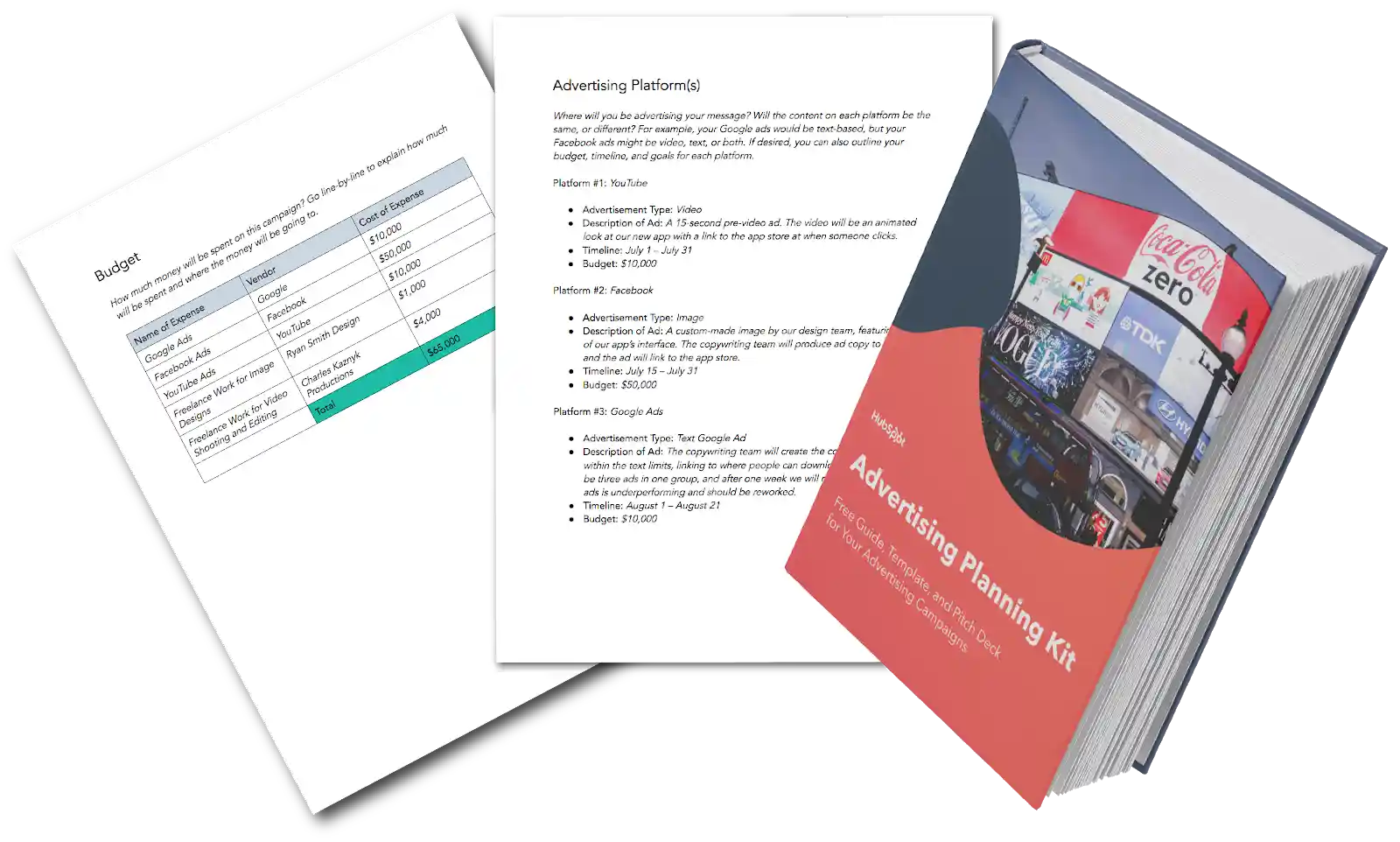 To make your advertising planning easier, use HubSpot’s free Advertising Planning Kit. Included are templates to help you plan and present your ad pitch, schedule your release dates, and inform your stakeholders. We’ve also thrown in an advertising best practices guide to help you choose the advertising method that works best for your business.
To make your advertising planning easier, use HubSpot’s free Advertising Planning Kit. Included are templates to help you plan and present your ad pitch, schedule your release dates, and inform your stakeholders. We’ve also thrown in an advertising best practices guide to help you choose the advertising method that works best for your business.
1. Define your target audience.
My first step is to clarify who I’m making the ad for. Pinpointing the right audience ensures that my ad cuts through the digital noise to reach people most likely to engage with my product or brand.
I’ve found that the more precisely I define my audience, the better. For example, if I’m promoting a new fitness app, I won’t target a broad audience like “people interested in fitness.” Instead, I’d target ”busy professionals aged 25-40 who are interested in getting fit via high-intensity interval training (HIIT).”
Those details let me create more personalized ads that speak directly to the challenges and interests of my target audience. That personalization helps boost revenues by 5 to 15% according to research from McKinsey.
2. Conduct market research.
After defining my target audience, I need to go deeper into their world. That’s where market research comes in.
Collecting and analyzing data to learn more about my potential customers helps uncover details like their demographics (age, gender, education level, location), psychographics (interests, values, lifestyles), and even their behaviors (purchasing habits, media consumption patterns).
That information helps me answer questions like:
- What is my primary target audience’s age range?
- What are their biggest pain points or challenges?
- What do they spend most of their time doing?
- Where do they live?
- What media or social platforms do they use?
- What types of ads do they commonly see?
There are multiple options for conducting market research. For instance, you can use existing market data, ask them to complete surveys or questionnaires, or even run a focus group.
Baruch Labunski, founder at Rank Secure, suggests an even more hands-on approach: “The best information comes from talking to people in a check-out line. Ask them what they want in a specific product or what would make them buy something.”
HubSpot’s Market Research Kit has everything you need to get started with market research for your ad campaign.
With research in hand, I build profiles of my ideal customers that will influence my decisions moving forward.
These buyer personas are fictionalized profiles that capture my potential customers’ backgrounds, interests, challenges, and how my product, service, or brand adds value to their lives.
My favorite tool to streamline creating buyer personas is HubSpot’s Make My Persona tool.
3. Decide on the ad format.

With my buyer personas to guide me, I need to choose the most effective format(s) to deliver my message. Each format has different strengths and weaknesses, and you may find that using a combination is best for your campaign.
Let’s break down some of the most popular ad formats.
Ad Formats
- Display ads. Appearing in websites and apps, these visual ads are usually served as banner ads or popups. According to Statista, display ads account for 30% of all digital advertising spending in the U.S.
- Video ads. Video’s ability to convey a lot of information quickly makes it popular, and research shows that 91% of businesses use videos as part of their marketing strategy. In fact, video marketing spending is expected to reach $120 billion in 2024. Video ads can be long or short but must be tailored to the advertising platform, whether streaming services, social media, or websites.
- Audio ads. Appearing on audio streaming platforms like Apple Music, Spotify, and Pandora, audio ads are typically 15-30 seconds long and can be music-driven or voice-overs. Like video advertising, audio is growing rapidly, with spending expected to reach $16.09 billion by 2029.
- Influencer marketing ads. Powered by social proof, influencer ads use an influencer discussing or using your product to convince their audience to buy. Influencer ads come in several types, including online videos, product reviews, influencer takeovers on social media, and sponsored content.
- Search engines. These text-based search ads look like a typical search entry plus a “sponsored” note on search engine result pages (SERPs). Because these are usually pay-per-click ads (PPC), how often your ad shows when a person searches for certain phrases or keywords may vary based on what your competition is paying for ads on the same keywords.
- Social media. Social media advertising is one of the fastest-growing advertising channels, with revenue expected to reach $262 billion by 2028. Ads on social media networks such as Facebook, Instagram, LinkedIn, and X (formerly Twitter) are available in several formats. Text, images, videos, carousels, and even sponsored content are available on different networks.
- Podcasts. Often overlooked, podcast advertising is relatively low-cost and reaches a well-targeted audience. Audio ads can be placed before, in the middle, and at the end of episodes, with some podcasts also offering video placements on streaming platforms.
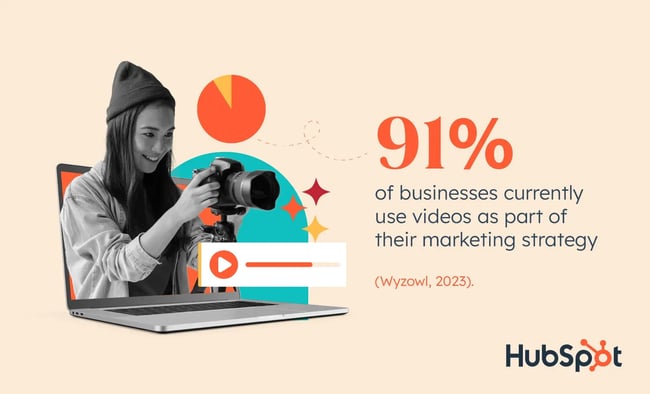
4. Determine the ad’s purpose.
Knowing who I want to reach and how I’ll say it is only part of the battle of how to make an advertisement. Now, I need to know what I want out of the ad.
What is the goal of the ad?
Ad goals usually fall into three categories:
- Brand awareness.
- Product awareness.
- Conversions.
Brand awareness builds a sense of familiarity and positivity with your target audience. The goal is to build credibility for the long term so you can make a sale easier later on. For example, if you say Boeing, most consumers immediately think aircraft.
Product awareness and conversions are both product-focused instead of brand-focused. The main difference is that product awareness focuses on sales later, while conversions focus on making a sale now. For example, limited-time sales promos would be conversion-oriented.
How to Make an Advertisement for a Product vs. for a Brand
When creating an ad for a product, the focus should be on that item. I want to point out the features and benefits of my product rather than just my brand’s overall product category.
Potential customers need to know what the product does and how it helps them. Depending on the product and the platform, I might even create a tutorial showing how to use the product.
In contrast, if I’m building brand awareness, I might talk more about our employees, company culture, history, and value position to build credibility and trust. Brand awareness ads need to connect emotionally for the long term rather than focus on a quick sale.
5. Choose a platform.

Image Source
My message’s platform must match the ad format and the target audience’s presence. For example, the perfect ad will fail if I choose a platform my customers don’t use.
HubSpot’s 2024 The State of Marketing report is my favorite tool for helping me narrow down what platform to use for the best ROI.
Use your market research findings (such as where your audience spends the most time online), ad goals (product awareness or brand awareness), and the chosen format to determine the platform that makes the most sense for your ad.
Ad Platforms
Kamel Ben Yacoub, CEO at Getupload, notes that “Paid search platforms like Google Ads are ideal for capturing existing demand from high-intent users actively searching for solutions. Google Users are directly typing the solution they are looking for in the search bar.”
However, social media ads on Meta, TikTok, and LinkedIn “are better for generating new demand and awareness reaching users who are not seeking your product but could be interested once they learn about it.”
Pro tip: Don’t restrict yourself to one platform.
For example, my market research might show that my target audience loves X and spends a lot of time on YouTube. A multi-platform approach also casts a wider net, increasing my chances of reaching more of my target audience.
6. Set a budget.
Outside of word-of-mouth advertising, ad campaigns take money, so I must set my budget.
There is no one-size-fits-all budget for ad campaigns. How much to spend depends on the purpose of the ad, the format, the platform, production costs, and how much your brand can afford.
Industry benchmarks and market data can provide a helpful starting point for understanding the average costs associated with different ad formats and platforms, as well as what similar brands are spending. For example, small- to medium-sized businesses spend an average of $1,000 to $7,500 per project on online ads.
Pro tip: Start small and then scale up with time.
Starting with a smaller budget lets you test different strategies, understand what works best for your target audience, and optimize your campaigns before making a larger investment.
Baruch Labunskis suggests that “Too many people want to put all their advertising money into the medium that is the flashiest. Instead, I would suggest stretching your budget further by focusing more of the campaign on the cheaper tools you can run more or longer.”
7. Craft your ad message.
Getting my message right is vital. Not only does the information have to be correct and serve the ad goal, it has to be engaging for the right audience. Even when I use copywriters, I have input into the ad message.
What exactly do I want my ad to say? How do I say it?
Revisit audience insights.
I always revisit my target audience’s needs, desires, and pain points before I draft ad copy. What are their aspirations or greatest desires? What keeps them up at night? By truly understanding their motivations, I can create a message that speaks directly to them and positions my product or service as the ideal solution.
Focus on the benefits.
Lauren Bayne, Founder and CEO of The Creative Brand Refinery, says: “People don’t care about specs; they want to know what problem your product or service solves.”
I always explain how the features translate into tangible benefits. For instance, rather than saying a vacuum cleaner has “strong suction power,” I might say it “cleans in one pass, so you have more time to enjoy the things you love.”
Create an attention-grabbing headline.
TL;DR is real, and your headline is prime real estate with the power to make or break your ad. Use a question, a surprising fact, or a benefit-driven statement to make them stop scrolling and click. My secret for creating killer headlines for ads and landing pages is HubSpot’s Free AI Headline Generator.
Set your product apart from the competition.
Clearly communicating my product’s unique selling proposition (USP) is vital. Why should someone choose my product over the competition? Whether superior quality, exceptional customer service, or unbeatable price, my USP must make a compelling case for why my product is the best choice.
Keep it simple.
Brian Town, CEO and founder of marketing and branding agency Michigan Creative, advises brands to keep the design as simple as possible because “A common pitfall in ad design is cluttering the ad with too much information, which can confuse the message.”
Include a clear call to action (CTA).
Leaving my audience wondering what to do next wastes my ad dollars. I must tell them what I want them to do with a clear and compelling call to action.
Domante Gerdauske, Digital Advertising Team Lead at marketing automation platform Omnisend, says you should always “adjust your CTA to your goals.” For example, for brand awareness, she recommends using “softer CTAs” like “Learn More” or “Visit Our Website.” and leaving “more action-oriented CTAs” for sales campaigns.
Pro tip: Place CTAs carefully.
Don’t let your audience miss a CTA. According to Mike Vanelli, Head Video Producer at Envy: “It should stand out visually and be placed in a contextually relevant spot to draw the user’s eye naturally.”
When I place CTAs, I always try to use a contrasting color scheme or slightly different font to grab attention and place it near a point of interest, like the product image or after a benefit description.
8. Develop or gather creative assets.
Once I have my message, I’ll use visual and auditory elements to support my ad message and capture attention. The type of creative assets you need will depend on the ad format and the platform but can include:
- Photography.
- Voice.
- Music.
- Video.
- Sound effects.
- GIFs.
- Animations.
Tools like Adobe Photoshop and Adobe Audition can help you edit these creative assets, or you can use a creative tool like Canva that includes drag-and-drop templates.
Another option is to use stock assets, either royalty-free, rights-managed, or copyright-free, that you can incorporate into your ads. However, remember to ensure that releases are available for any recognizable people and places in the assets.
Popular stock asset sources include:
- Stock photos and illustrations. Shutterstock, Pixabay, and iStock.
- Stock video footage and audio. Pond5, Pexels Videos, and Videvo.
- Music and sound effects. AudioJungle, Free Music Archive, and Epidemic Sound.
If your budget allows it, you can hire freelancers or a professional agency for video editing, photography, sound mixing, and copywriting.
9. Create a test mock-up.
I always test ads before launching a campaign. I recommend this step because:
- Ad designs may not work in all formats. Mock-ups help me visualize an ad’s appearance on the chosen platform and identify potential issues. For example, a horizontal video might not crop well to vertical.
- It helps me spot errors. A mock-up is a quick way to spot errors like off-brand messaging and colors.
- Feedback is critical. I can show the mock-up to colleagues or test audiences for feedback. Their constructive criticism helps me identify areas where the message isn‘t clear or the visuals aren’t engaging so I can make adjustments to ensure a high-quality final product.
10. Create the final ad.
Now, it’s time to bring the ad to life by combining all your developed elements into a cohesive piece ready to run. If you have a rough draft from the previous step, this is where you polish and refine it. That might include tightening the copy, fine-tuning the visuals, and basically ensuring everything flows smoothly.
Again, you can choose a DIY approach using tools like Canva or Photoshop or outsource the ad’s creation to a freelancer or professional ad agency.
How to make a simple video ad in Canva.
To create a simple video you can run on a platform like YouTube or social media using Canva, follow these steps:
Step 1: Open Canva and type “Video Ads” into the search field.
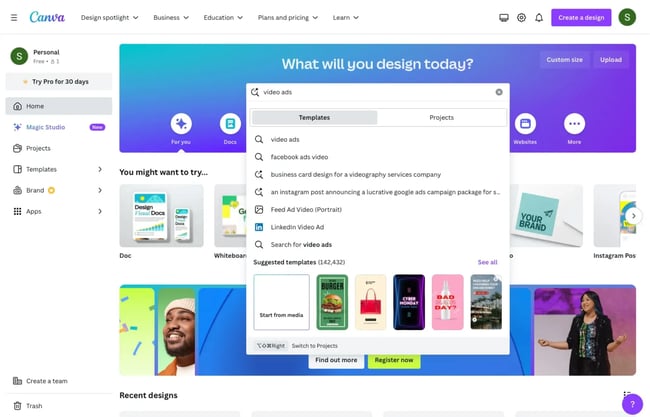
Image Source
Step 2: Browse Canva’s library of video templates to find one that matches your vision, style, and platform formatting.
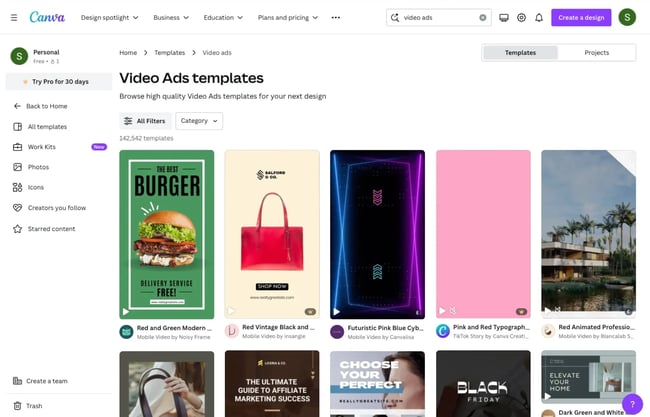
Image Source
Step 3: Customize the template. Canva’s video ad templates come with pre-designed elements like text boxes, images, video clips, and music. You can replace these elements with your own content.
- Upload your visual elements: Click on Uploads and select your desired file. Then, drag and drop it onto the template. Canva also offers a library of free and premium stock assets. Just be sure to read the licensing terms before use.
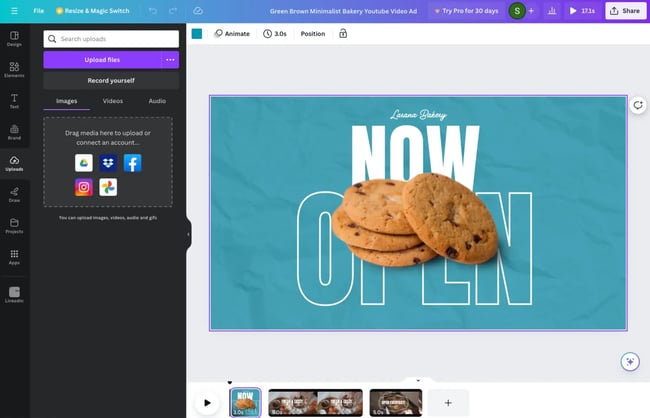
Image Source
- Replace text placeholders: Click on the placeholder text and replace it with your copy.
Step 4: Edit the fonts and colors to reflect your brand style and identity by clicking Styles.
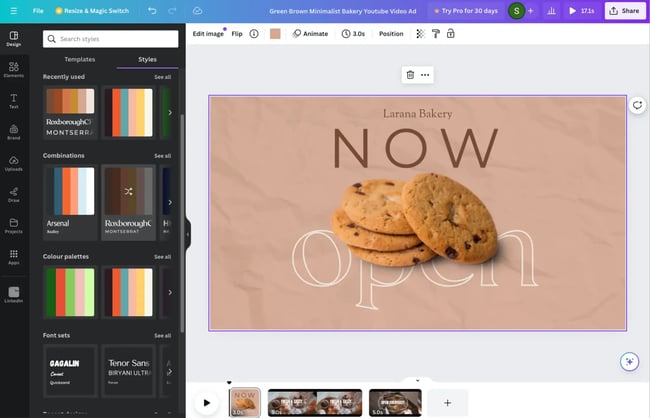
Image Source
Step 5: (Optional) Enhance your video with animations, other visual effects, and audio.
Step 6: Click the play button to preview your video ad and ensure everything looks and sounds good. Adjust the visuals, text, or audio elements as needed.
Step 7: Once satisfied, download your video ad in your preferred format and resolution.
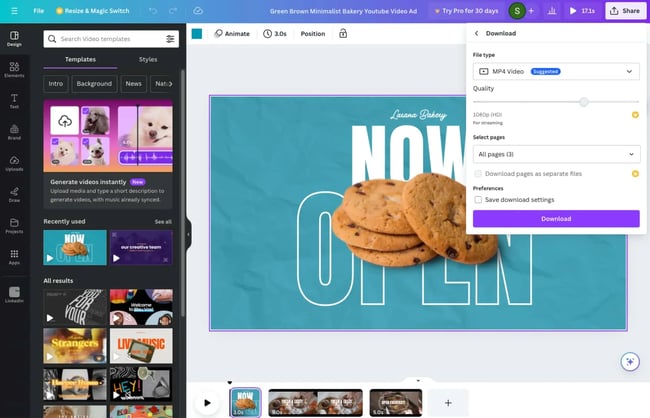
Image Source
11. Check the small details.
The smallest details can impact ad success. Picture this: you’ve crafted a fantastic ad for a concert your company is hosting. You’ve identified your target audience, developed a compelling message, and included a clear call to action.
However, one crucial detail is missing: the ad doesn‘t mention where or when the event is happening. While viewers might click through to your website for specifics, there’s no guarantee they’ll take that extra step and buy a ticket without details first.
So, before releasing my ad, I always do a final check to ensure I’ve not overlooked any crucial details that could prevent viewers from taking action.
12. Determine how to measure success.
The final action I take before officially launching my ad is defining how to track results. I know what I want to achieve from Step 4, but I need to measure it.
I take the overarching goal I defined earlier and break it down into specific, measurable objectives. For example, suppose my goal is building brand awareness. In that case, I might define success as reaching a specific number of people with my ad on a relevant platform.
If my goal is sales, I might define success as a certain number of sales generated through ad clicks or by the use of a promo code.
Determine key performance indicators (KPIs) or metrics you’ll track to measure progress or success. KPI examples include:
- Impressions. The number of times your ad is displayed.
- Clicks. The number of times users click on your ad.
- Click-through-rate. The percentage of people who see your ad and click on it.
- Conversion rate. The percentage of people who see your ad and complete a desired action.
Don’t get overwhelmed, and try to track every possible metric. Focus on a handful that directly align with your ad campaign goals for better results. Personally, I like to focus on no more than three KPIs per campaign.
13. Launch your ad.
Now’s the moment of reckoning — putting your ad out there for the world to see. How you launch your ad will be different for each platform.
I like to review each platform’s steps frequently to ensure I have all the details covered. Here are some of my favorite resources for launching ads on traditional and social media advertising platforms:
- How to Launch a Facebook Ad
- How to Launch a LinkedIn Ad
- How to Launch an Instagram Ad
- How to Launch an X (Twitter) Ad
- How to Launch a YouTube Ad
- How to Launch a Google Ad
- How to Launch a TV Ad
- How to Launch a Billboard Ad
14. Track and analyze performance.
The work isn’t over after I’ve launched my ad. While the ad runs, I need to analyze and track its performance, focusing specifically on the metrics I defined earlier.
Thankfully, most digital platforms — including search engines, social media platforms, and display networks — have built-in analytics tools that make it extremely easy to measure and track most of these metrics, including impressions, clicks, and conversions.
For those that don’t have these inbuilt analytics, most easily integrate with external tracking and ad management tools, including my favorite, HubSpot’s own Ad Management Software.
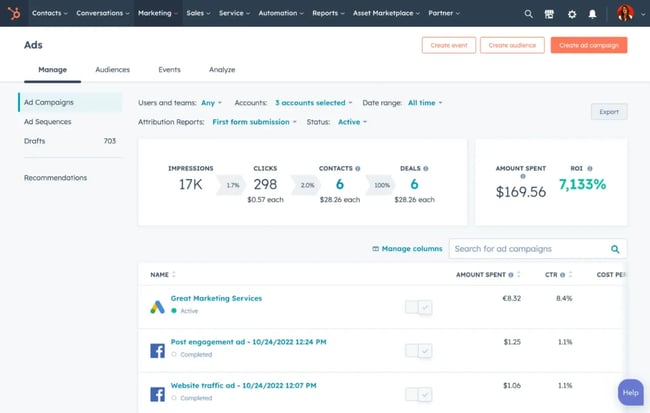
Image Source
By closely monitoring an ad‘s performance, I can determine whether it’s meeting my goals and identify areas for improvement. Analyzing data over time reveals patterns and trends that help me optimize future ad campaigns for even better results.
15. Continuously optimize your ad.
Many platforms have the ability to tweak ads during their run.
I might slightly adjust the ad copy, test new visuals, refine audience targeting, or adjust spending. For example, if I run multiple ads and one starts going viral, I’ll shift some budget away from other ads and put more into the popular one.
Another powerful technique I recommend is A/B testing. For A/B testing, I create several versions of my ad with different headlines, images, and CTAs and run them at the same time to see which works better.
Over time, those results help me identify the winning elements and optimize my future ad campaigns for maximum impact.
Start Creating Great Ads Today
Well-crafted ads can do wonders for your business, but the best ads require careful planning and strategic execution.
Don’t wait longer to unlock the power of effective advertising. Use our comprehensive “how to make an advertisement” guide to create eye-catching ads that produce positive outcomes for your brand.
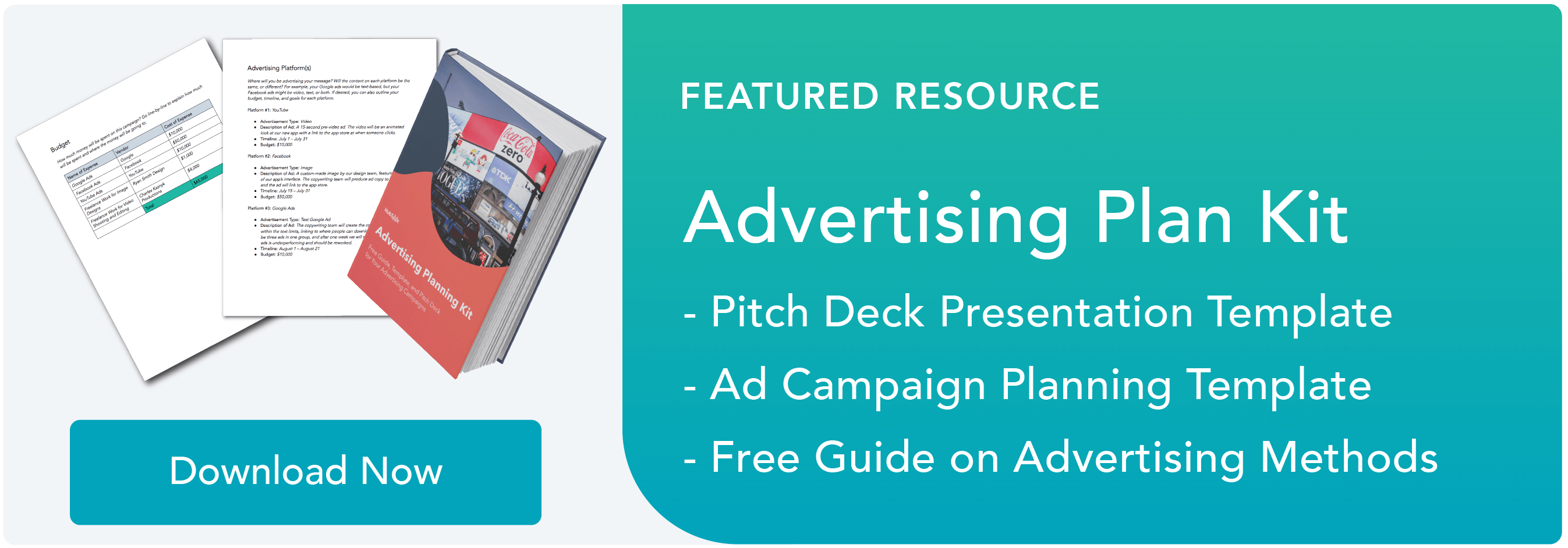
![]()
If Hubspot is of interest and you'd like more information, please do make contact or take a look in more detail here.
Credit: Original article published here.
